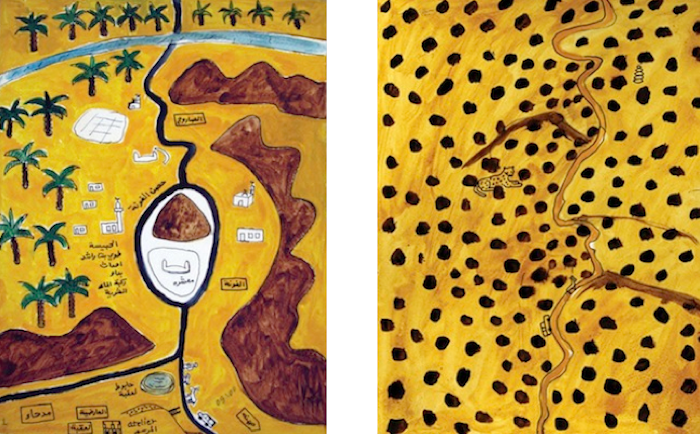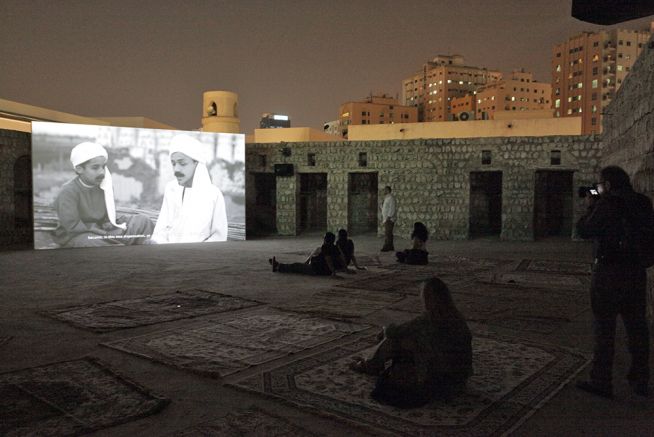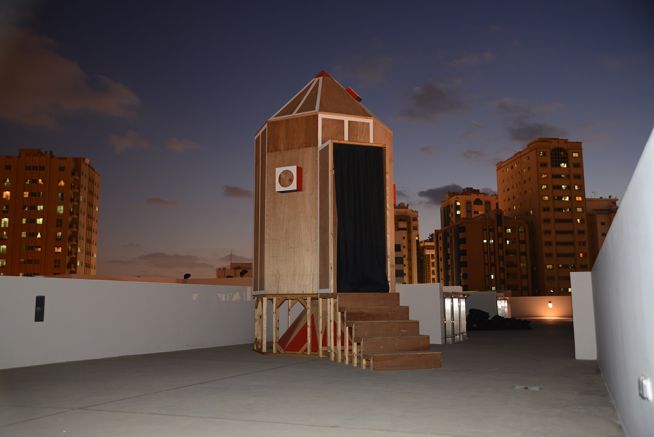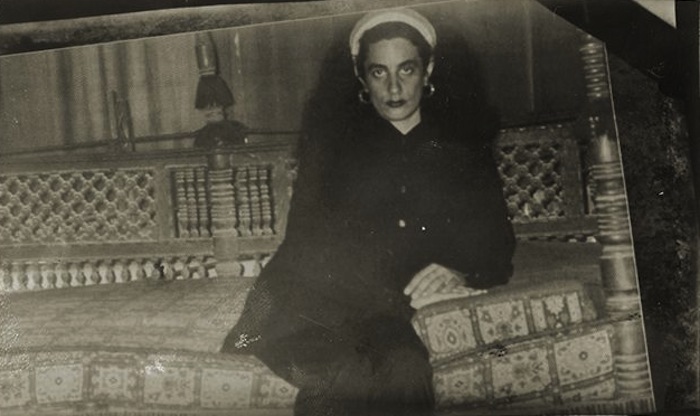Sharjah Art Foundation exhibitions between April and June 2014

Now that art season in Dubai is over, it's time to focus on Sharjah. Currently, there are several exhibitions organised by the Sharjah Art Foundation on between now and mid June. They all opened a couple of months ago and I have not yet had a chance to go.
All of the exhibitions are within walking distance from each other (look at the maps here), with several outdoor installations. There's a lot to see, it's like a mini Sharjah Biennial, so block a day over the weekend or go and spend the afternoon/evening there. I promise you it will be quite an experience.
Here's a run down of the exhibitions and here's a location map of Sharjah Art Foundation and exhibition spaces.
Exhibitions on till 22nd May 2014
Eduard Puterbrot: Between my East and my West
Building J, SAF Art Spaces
Eduard Puterbrot - Red Mountain, 1989, oil on canvas, 55.5x70 cm
Between my East and my West, presents a selection of works by the late Dagestani artist, Eduard Puterbrot, tracing the artist’s journey and work spanning two decades. While central to his work are Dagestani folk tales and culture, Puterbrot depicts the balance between East and West and uses various styles and techniques, including theatre and stage design to portray these differences.
Abdallah Al Saadi: Al-Toubay
Bait Hussain Makrani and Bait Hassan Mukhtar

Abdullah Al Saadi, Camar Cande’s Journey, 2010–2011 Installation, video, 151 watercolour paintings, dimensions variable | Commissioned by Sharjah Art Foundation
This exhibition focuses on a few works from Abdullah Al Saadi’s long history as an artist. Some of these projects, which he has just completed were works in progress for a decade. Companionship is at the very centre of his long journey and has contributed to this exhibition in many ways.
From his donkey in Camar Cande’s Journey (2010-2011), to the animals in The Comparative Journey (2013), to his mother in My Mother’s Letters (1998-2013) and The Watermelon Series (2013) each of these companions has had a profound influence on these projects. His more fantastical works, like The Comparative Journey (2013) explore how the need for companionship can even lead to relationships with inanimate objects, such as stones, which represent the various animals that later became companions on yet another journey.
The hardships of these travels reflected in the Stone Slippers (2013) and the diaristic accounts and drawings reflect the life of a gypsy or nomad continuously travelling and searching for something.
Ahmed Mater: 100 Found Objects
Building F, SAF Art Spaces
Ahmed Mater, 100 Found Objects, Policeman whistle, Makkah Al Mukarramah, 1924, dimensions variable
Ahmed Mater, 100 Found Objects, Alkaram Makkah viewmaster, 1980-2000, dimensions variable
100 Found Objects includes images, videos and research material that Ahmed Mater has collected which chronicle Makkah’s past to its present identity. Throughout his research, Mater has gathered a rich archive of conversations.
They include personal references and continuous recordings of the urban developments and expansion of Makkah, some of which are presented in this exhibition. This unique archive draws on wider political and familiar histories of communities that once lived in Makkah’s vicinity. Along with distinctive pilgrims' tales, both the intimacy and the anonymity implicit in mass congregations of peoples from all over the world is revealed.
We are taken on a passage that encompasses individual recollections of broad social and political events. Personal and collective dreams and ideologies are reflected through symbolism associated with a site that draws on the visions of every man, woman and child interconnected by a shared religious faith.
100 Found Objects is an ongoing work which will be completed once the entire expansion and development of Makkah is accomplished.
Exhibitions on till 13th June 2014
Wael Shawky: Horsemen Adore Perfumes and other stories
Building P, Bait Al Aboudi, Bait Gholoum Ibrahim; SAF Art Spaces

Wael Shawky, Al Araba Al Madfuna II, 2013, black-and-white video projection with sound, installation shot
Wael Shawky uses a range of media to explore issues of history, religion, culture and the effects of globalisation on society today. In video, photographs, installations and performance, he mines traditions of entertainment and performance through multilayered works that force viewers to navigate the territory of truth, myth and stereotype.
Religion and the tradition of storytelling – both oral and written – play a central role in Shawky’s aesthetic. His work often captures settings and social practices that present unexpected moments of irony: significant texts are translated into different languages; age and authority become inverted; and the separation between religious and social rituals is blurred.
Curated by Sharjah Art Foundation Director Hoor Al-Qasimi, this exhibition highlights Shawky’s interest in how history is rewritten, documented and interpreted through a series of videos, installations, sculptures and drawings, including his new work Al Araba Al Madfuna II, co-produced by the Wiener Festwochen and Sharjah Art Foundation.
Rasheed Araeen: Before and After Minimalism
Building I, SAF Art Spaces
Raheed Araeen, Boats at Keamari, 1958-1959, watercolour on paper, 6 paintings, dimensions variable. Araeen Family Collection, Karachi
Rasheed Araeen: Before and After Minimalism presents sculptures, paintings and drawings created during the more-than 50-year career of this influential Pakistani-born British artist.
The exhibition traces his evolution as a painter in Karachi to his shift towards Minimalism in London and ultimately to his international recognition and achievements as a post-Minimalist sculptor.
Trained as a civil engineer, Araeen is best known for his formal, geometric sculptures often created from simple, sometimes industrial materials. Eschewing traditional sculptural hierarchies and compositional concerns, Araeen’s works are informed by his social and political convictions.
Founding editor of important critical journals including The Third Text, Araeen has been at the forefront of the politically charged discourse between artists, institutions and audiences. This first major exhibition of the artist’s work in the MENASA includes early paintings and drawing, documentation of participatory and performance works, seminal sculptures from the 1960’s and a new sculpture specially commissioned for Sharjah.
Susan Hefuna: Another Place
Bait Al Serkal, Arts Area, Al Shuweiheen
Susan Hefuna, "4 Women - 4 Views", 2001, Photography, 130x200 cm. Courtesy of the artist
Another Place, exhibition space (image via susanhefuna.com)
Installed in a converted traditional Emirati home, this major exhibition brings together a large selection of work by the German-Egyptian artist Susan Hefuna. Sculpture, drawing, photography and videos, created from the 1980s to the present day, reveal the artist’s focus on structure in her practice, both directly and indirectly, through these different mediums.
In the grid patterns of her mashrabiya works, the lines of her drawings, or the lattice-like structure of her palm-wood towers placed in the courtyard of Bait Al Serkal, Hefuna traces the intersections between identity, social politics and place. This exhibition includes drawings from Tokyo, Istanbul, New York and a new series titled Sharjah Ceilings created specifically for this exhibition.
The intimate setting of Bait Al Serkal underscores the tension between public and private that is central to Hefuna’s practice and offers a framework for understanding the links between the works the artist has created over the course of her career.
Exhibitions on till 16th June 2014
March Project
Bait Al Shamsi, SAF Art Spaces

Noor Al Bastaki, Sawalef (Tales), 2014, installation, video, dimensions variable

Frank Harris, Spaceship Sharjah, 2014, installation, wood, lenses and paint
The March Project is an educational residency programme for young artists that provides opportunities to research, realise and present site-specific works through a series of professional development courses, seminars, exhibitions, site visits and talks led by art practitioners over a five month period.
Participants in this programme were chosen from the Gulf and abroad including recent graduates from institutions such as Slade School of Fine Art (UK), MASS Alexandria (Egypt), Al Riwaq (Bahrain), Higher Colleges of Technology (UAE) and Zayed University (UAE).
This exhibition features the work of seven young artists. The works realised in this exhibition draw upon the role of architecture, space and movement in the hybrid culture and society of Sharjah. The interactions in Sharjah between residents and its private and public spaces, as well as the occupation and use of these places, play a central role in these site-specific works installed throughout SAF Art Spaces and Bait Obaid Al Shamsi, in the Arts Area.
Location map of Sharjah Art Foundation and exhibition spaces
Map of the Sharjah Art Foundation Art Space
www.sharjahart.org/exhibitions-events/current-upcoming-events





